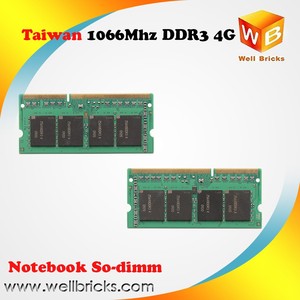
All categories
Featured selections
Trade Assurance
Buyer Central
Help Center
Get the app
Become a supplier

(125 products available)



























The DDR3 10600E is an error-correcting memory module used in servers. It comes in two main types: registered and fully buffered. Both types use a buffer or register between the memory controller and the memory banks to improve system stability when using large memory capacities. This enhancement is accomplished by decoupling the electrical load of the DIMM from the memory controller. This allows for increased memory capacities and improved performance in servers and workstations.
Registered DIMMs (RDIMMs) allow for increased memory capacity in servers and workstations by including a register between the DRAM modules and the memory controller. This register captures and stores the address and control signals before transferring them to the memory modules. By doing so, it reduces the electrical load on the memory controller, allowing for greater stability when using a large number of DIMMs. RDIMMs are commonly used in systems that require high memory capacity and reliability, such as enterprise-level servers and computing systems.
Fully Buffered DIMMs (FB-DIMMs) are an advanced type of registered DIMM that offer even greater memory performance and capacity. They incorporate a memory buffer that fully buffers the data, address, and control signals before sending them to the DRAM modules. This technology allows for better signal integrity and faster data transfer rates compared to traditional DIMMs. FB-DIMMs are particularly beneficial in applications that demand intense memory bandwith, such as virtualization, databases, and scientific computing. With their enhanced performance and ability to support larger memory capacities, FB-DIMMs provide a solution for systems requiring exceptional memory capabilities.
The DDR3 10600e has several noteworthy features that enhance its performance and power efficiency. Here is a summary of some of its key characteristics:
DDR3 10600E can be used in various situations. Below are some applications of the DDR3 10600E memory:
Before choosing DDR3 memory, consider which type of PC it will be used for. This is because each kind of PC has different memory needs. Laptops require modules made for portable machines, while workstations require high-capacity memory. Gamers should look for modules with lower latencies.
Lower latency means there's less delay when transferring data. Optimized DDR3 memory with dynamic voltage scaling is a good choice for gamers. Using different voltage levels on different loads helps reduce memory module latency.
Compatibility is a significant factor when choosing DDR3 memory. It must match the motherboard's requirements. Consulting the motherboard manual is an excellent way to find out about compatibility. Manufacturers usually include information about compatible memory modules and the number of slots available.
Users can also check the motherboard manufacturer's website. They will find information about compatible memory types and other features like DDR3 10600E. It's also good to know that there are two kinds of DDR3 memory modules. One is for desktops and laptops, while the other is for servers and workstations. The latter has a register that helps it operate in multi-server environments.
When upgrading, users should take note of the memory modules already installed in their PCs. This is because they must use memory sticks with similar characteristics to what's already set up. Modules with different speeds and latencies can work together, but they will operate at the lowest speed. They must also have the same capacity.
The general rule is to replace old DDR3 memory with a newer version. In some cases, however, it makes sense to keep the old memory. If it's possible to add a new module without replacing the old one, it's better to upgrade to a higher capacity without replacing the old module. Using a higher capacity will have a more significant performance impact than using a newer version.
Marketing labels can be misleading sometimes. Memory modules are faster depending on the brand, but this isn't always true. Buyers should do further research before being swayed by marketing. Online reviews are a good resource when learning about performance differences. Using a reliable supplier is critical. Restorer believed that sellers have better memory module knowledge and are more likely to stock quality modules.
Q1 Is it possible to combine DDR3 10600E memory with other DDR3 EC or REG modules?
A1 No, it is not advisable to mix different types of memory modules. This is because DDR3 10600E is designed for error-correcting code (ECC) and registered (REG) memory slots. The module will not work on a standard DDR3 slot, and vice versa for the other types of RAM.
Q2 What system can use a DDR3 10600E SDRAM?
A2 The DDR3 10600E RAM is commonly used in servers and workstations. It is suitable for systems that prioritize data integrity and stability, such as financial computing, scientific research, and server databases.
Q3 Can DDR3 10600E be used in a laptop?
A3 It depends on the specific laptop model. Most laptops use SO-DIMM, which is a smaller version of DIMM. If a laptop supports DDR3 ECC memory, it can use DDR3 10600E. Checking the laptop's specifications and documentation is necessary.
Q4 What happens if a non-ECC RAM is added to a DDR3 10600E supported system?
A4 The system will still boot and work normally. However, the non-ECC RAM will not have the error-correcting features that ECC RAM has. This means that data errors might occur, which the non-ECC cannot fix.
Q5 Does DDR3 10600E work with all motherboards?
A5 No. The DDR3 10600E works only with motherboards that support DDR3 type RAM. To know this, users can check the motherboard manual or specifications online. Using a RAM type that a motherboard doesn't support can lead to failure to boot.